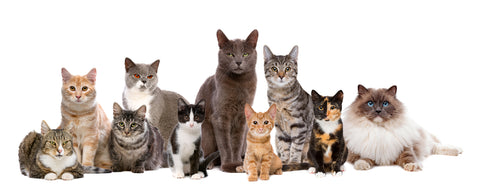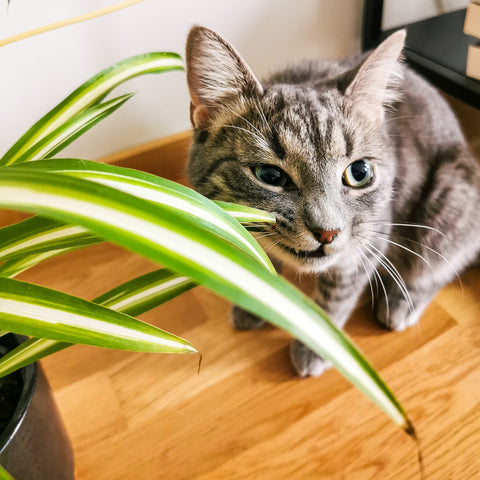
You may find your cat is rubbing one of their eyes with a paw, or notice that their eye looks red and inflamed. This is a sign that your feline friend may be suffering from cat conjunctivitis. You may be asking yourself, “does my cat have pink eye?” Continue reading to find out more about cat conjunctivitis, also called pink eye—everything from how to recognize signs of this condition to what causes it and how to treat it.
Do Cats Get Conjunctivitis?
The simple answer is yes, all cats are susceptible to conjunctivitis, also referred to as pink eye. Pink eye is an inflammation of the conjunctiva, which is the thin mucous membrane that lines the inside of your cat’s eyelid.

No one cat breed is immune to cat conjunctivitis, nor is any breed more likely to get cat conjunctivitis than another. Conjunctivitis in cats is non-heritable, meaning that it's not a genetic disease passed down from a parent.
Pink eye can occur in cats of all ages, though it is often more prevalent in younger cats. Older cats are less likely to get cat conjunctivitis, as their immune systems are more developed and they typically build up natural immunity to the condition over time. Younger kittens of the same litter, cats in shelters or other places where there are many cats in one place, or multiple cats who live and play together are all examples of how conjunctivitis can more easily pass from one cat to another.
Common Symptoms of Conjunctivitis in Cats
To help ensure the best possible outcome, it is always best to notice changes in your cat and seek treatment for an issue like conjunctivitis sooner rather than later. Let’s cover signs of the early stages of conjunctivitis in cats so that you know what to look out for.
Symptoms of pink eye include blinking excessively, squinting, or keeping one or more of their eyes closed. These are a natural response to the irritation and discomfort your cat experiences as a result of the infection. You may also see excessive watering/tearing, or even a cloudy, yellowish mucus in your cat’s eye. If your cat is constantly rubbing its eye, and you may notice patches of hair loss on the skin surrounding the eye.
Beyond these physical symptoms that you can see in your cat’s eye(s), your cat may exhibit signs of an upper respiratory infection, which include:
- Nasal Discharge
- Sneezing
- Your cat will become lethargic
- Decrease in appetite

If you notice any upper respiratory or eye symptoms, you should take your cat to your veterinary clinic as soon as possible. Cat conjunctivitis can spread from one eye to the other or to another cat in your home, so it is important to address it quickly and get your cat the treatment and relief that it needs.
Causes Of Conjunctivitis in Cats
There are two types of conjunctivitis: infectious and non-infectious.
Infectious Causes
Infectious conjunctivitis is caused by a viral or bacterial infection of the conjunctiva of the eye. This type of infection often causes conjunctivitis to start in one eye and spread to the other. There are 3 main types of infectious conjunctivitis in cats that we will discuss below: viral conjunctivitis, bacterial conjunctivitis, and parasitic conjunctivitis.
Viral Conjunctivitis
The primary cause of conjunctivitis in cats is viral. The most common cause of viral conjunctivitis is feline herpesvirus-1 (FHV-1). This virus is highly contagious to other cats who are in close proximity to the infected cat. However, this virus cannot be spread to humans. FHV-1 hides in the cat’s nervous system and can be activated randomly whenever your cat becomes ill or stressed. As many as 97% of cats will be exposed to feline herpes virus sometime in their life, and FHV-1 causes a lifelong infection in up to 80% of cats that get exposed.
The other type of common viral conjunctivitis is the calicivirus. This virus usually presents as eye, mouth, or nose secretions. This virus, like the FHV-1 virus, is also easily spread to other cats in close proximity and unfortunately, cats also become lifelong carriers of calicivirus.
Bacterial Conjunctivitis
Cats who may start with a viral conjunctivitis infection often get secondary bacterial infections. While bacterial conjunctivitis occurs less frequently than viral conjunctivitis, Streptococci and Staphylococci are the most common bacteria that cause infections such as conjunctivitis. Chlamydophila Felis is another bacterium that can also cause bacterial conjunctivitis, that also has the ability to infect humans, especially in people with weakened immune systems.
Parasitic Conjunctivitis
Parasitic conjunctivitis occurs when cats’ eyes get infected by different kinds of parasitic worms, such as nematodes. However, cats in warmer, tropical areas who are free to roam the outdoors are typically more prone to infection from parasites.
Non-infectious Causes
Non-infectious causes of conjunctivitis occur as a result of a foreign object getting into your cat’s eye and becoming trapped. Something as simple as dust or sand can get trapped under the eyelid and can cause irritation and a secondary bacterial infection.
Immune-Mediated
While uncommon, conjunctivitis can occur as a result of a cat’s immune system being compromised and“attacking” itself. Immune-mediated conjunctivitis may be caused by certain eye or eyelid diseases, which can cause friction and inflammation of the eye. Allergic reactions to dust, pollen, fleas, or other environmental factors can also lead to this type of conjunctivitis.
How Is Conjunctivitis Diagnosed And Treated?
It is always important to have your cat seen by your veterinarian if they are experiencing symptoms of conjunctivitis or other eye irritation. While some cases of pink eye can go away on their own, your vet will be able to determine the cause of your cat’s eye condition and appropriate treatment so that your cat doesn’t needlessly suffer.

To make a diagnosis, your vet will carefully examine your cat’s eyes, which includes looking for any foreign debris lodged in the eyelid, scratches or other potential damage to the eye, and other signs of inflammation. If needed, your vet may use a dye in your cat’s eye that can be seen under a special light, which can help them see scratches or ulcers on the cornea (clear dome-like part of the eye). Your veterinarian may also perform blood work to determine if there are any other signs of infection in your cat’s body.
Treatment will depend on the underlying cause and severity of your cat’s case. It may include antibiotic eye drops or ointment or for more severe cases, antiviral drugs may be needed. Your vet will recommend the most appropriate treatment to help your cat get rid of the infection and the pain and inflammation that it is causing.
Recovery and Prevention of Conjunctivitis
Depending on the severity and type of conjunctivitis your cat experienced, they will typically make a full recovery. However, viral conjunctivitis such as the type caused by the feline herpes virus, can recur when your cat is stressed or their immune system is compromised. Regular wellness visits to your veterinarian, providing a high-quality diet, and staying up-to-date on your cat’s vaccinations will all help to keep your cat happy and healthy in the long term.
Vaccination
Ensuring your cats have all the necessary vaccination injections is crucial, particularly for the feline herpes virus. The common flu can even cause conjunctivitis, so be sure to ask your vet what vaccines your cat needs to best support their health.
Good Hygiene
Cat hygiene is vital and can make a big difference when it comes to conjunctivitis. If you have a kitten, it is a good idea to frequently clean their eyelashes with a warm cloth to keep dust from going into their eyes. Washing your cat’s bedding is also important, to help keep dirt, fleas, and allergens away and help prevent other common skin problems that affect cats.

Stress-Free Environment
When your cat is stressed it affects their immune system, which can make fighting off an illness more difficult. Creating an enriching environment at home and supporting them in times of anxiety or stress can help you keep your kitty happy, healthy, and calm.

Conclusion
When you decide to become a cat owner, from that moment you are responsible for taking care of your new furry friend, especially when they get sick. From when they first experience skin allergies to cat conjunctivitis it is your responsibility. Your cat may experience a wide array of health conditions which is why it is so important to be aware of all kinds of illnesses, especially cat conjunctivitis.
Get Ahead Of Other Health Issues With Basepaws

Basepaws is here to help you get to know your cat better—both inside and out—with our Breed + Health Cat DNA Test and Oral Health Test for Cats to give you deep insight into every aspect of your cat's health. Learn about 25 genetic traits connected to your kitty’s unique appearance, and potentially life-saving information about their blood type and likelihood of resistance to Feline Immunodeficiency Virus (FIV).
In addition to 43 genetic diseases, Basepaws screens your cat's mouth for signs of periodontal disease, halitosis, and tooth resorption. These issues are painful and difficult to see with the naked eye, and poor oral health puts your feline friend at risk for heart, kidney, and other conditions. By knowing your cat’s risk for disease, and how their oral health connects to their overall health, you can be proactive and support their well-being to help them live a better life, even longer!



